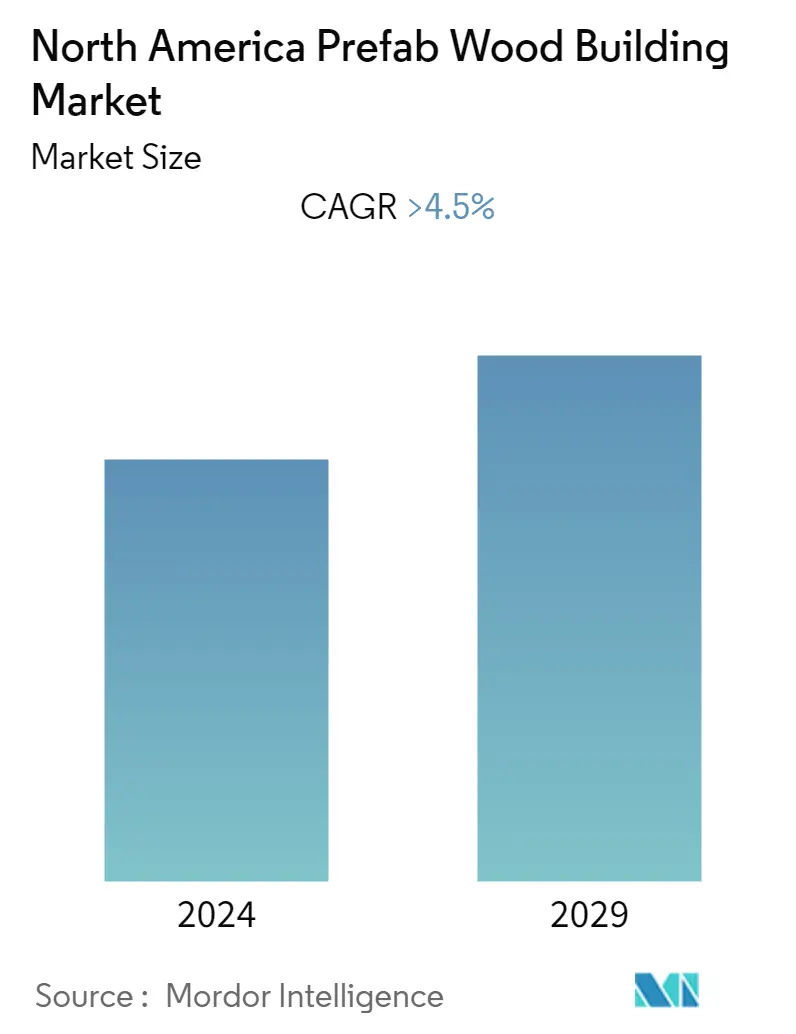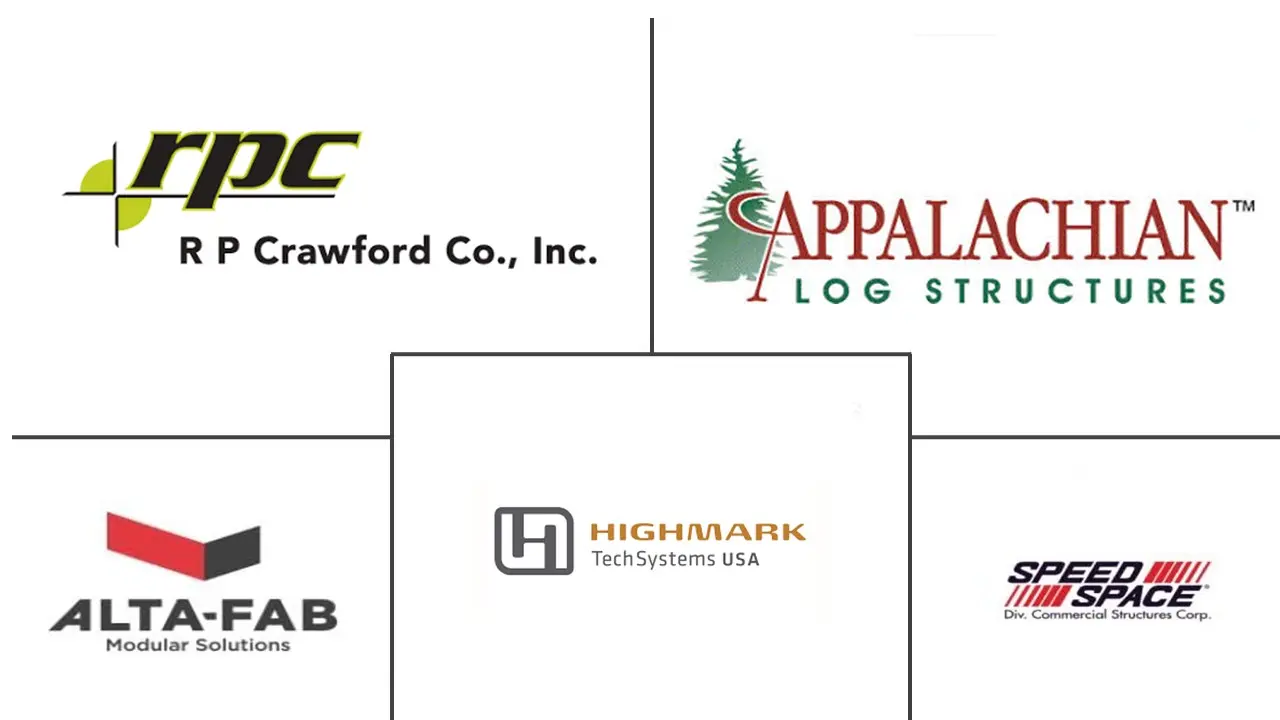Market Size of North America Prefab Wood Building Industry

| Study Period | 2020 - 2029 |
| Base Year For Estimation | 2023 |
| Forecast Data Period | 2024 - 2029 |
| Historical Data Period | 2020 - 2022 |
| CAGR | 4.50 % |
| Market Concentration | Low |
Major Players
*Disclaimer: Major Players sorted in no particular order |
North America Prefab Wood Building Market Analysis
The size of North America Prefab Wood Building Market is ~USD 4 billion in the current year and is anticipated to register a CAGR of over 4.5% during the forecast period.
- The productivity of various building projects in North America has been delayed due to a manpower shortage during COVID-19. In addition, the pandemic has boosted offsite construction in North America, which offered improved safety, reduced risk, and greater certainty of completion on time and within budget. The combination of additive manufacturing with energy-absorbing materials, such as micro houses, is expected to boost regional industrial growth. Other factors driving growth include rapid urbanization in developing parts of the region and increased investment in the real estate sector.
- The US economy is also driven by massive internal migration. Americans are known for a tendency to move all over the country. Roughly 35.5 million Americans move each year, and over the years people may change homes up to five times. Building wooden houses, quickly and affordably, allows them to easily relocate without leaving too much behind. The United States is a country of speed, convenience, and ready-made solutions. That's reflected in their cuisine, their work culture, and most definitely their housing preferences.
- The prefabricated wood building manufacturing business is made up of around 570 companies that employ over 19,000 people and produce approximately USD 4.4 billion per year. New federal and state laws, requiring structural integrity and consistent construction methods, were adopted. Plywood, plastics, and aluminum, all of which were subsequently used in wood prefab units, increased sales as well.
- The United States Department of Commerce released a final finding in the third annual assessment of Canadian softwood lumber imports, lowering the tariff rate from 17.99% to 8.59%. Industry groups such as the NAHB and the National Lumber and Building Material Dealers Association have been lobbying for lower tariffs on Canadian softwood lumber to enable more affordable housing.
North America Prefab Wood Building Industry Segmentation
Wooden prefabricated buildings involve premade pieces that are constructed off-time. Prefabricated wood building kits, similar to life-sized Legos, are made up of prefabricated components that are delivered and assembled on-site. Furthermore, this report covers market insights, such as market dynamics, drivers, restraints, opportunities, technological innovation, its impact, porter's five forces analysis, and the impact of COVID-19 on the market. In addition, the report also provides company profiles to understand the competitive landscape of the market.
The North America Prefab Wood Building Market is segmented By Panel Systems (Cross-laminated timber (CLT) panels, Nail-laminated timber (NLT) panels, Dowel-laminated timber (DLT) panels, and Glue-laminated timber (GLT) columns and beams), By Application (Single Family Residential, Multi-family Residential, Office, Hospitality, and Others) and By Geography (United States, Canada, Mexico, and Rest of North America). The report offers market size and forecasts for North America Prefab Wood Building Market in value (USD Billion) for all the above segments.
| By Panel Systems | |
| Cross-laminated timber (CLT) panels | |
| Nail-laminated timber (NLT) panels | |
| Dowel-laminated timber (DLT) panels | |
| Glue-laminated timber (GLT) columns and beams |
| By Application | |
| Single Family Residential | |
| Multi-family Residential | |
| Office | |
| Hospitality | |
| Others |
| By Country | |
| United States | |
| Canada | |
| Mexico | |
| Rest of North America |
North America Prefab Wood Building Market Size Summary
The North America prefab wood building market is experiencing a notable transformation, driven by factors such as urbanization, real estate investment, and the shift towards offsite construction methods. The COVID-19 pandemic has accelerated the adoption of offsite construction due to its benefits in safety and project management. The market is characterized by a diverse range of companies, with significant employment and production capabilities. The United States, in particular, is witnessing a trend towards quick and affordable housing solutions, aligning with the country's fast-paced lifestyle and mobility patterns. The market is also influenced by regulatory changes and the use of innovative materials like cross-laminated timber, which is gaining traction for its eco-friendly and versatile applications in both residential and commercial projects.
In Canada, the focus on sustainability and renewable resources is reshaping the building sector, with government initiatives promoting the use of wood in construction to support the transition to a low-carbon economy. The mass timber and modular construction technologies are becoming increasingly popular due to their energy efficiency and cost-effectiveness. The Southern United States is emerging as a key supplier of softwood lumber, bolstered by its vast forest resources and new sawmill projects. Despite the slow adoption of cross-laminated timber, recent developments suggest a potential increase in its use, supported by changes in building codes and insurance coverage. The market remains competitive and fragmented, with major players continuously enhancing their offerings to meet evolving consumer demands.
North America Prefab Wood Building Market Size - Table of Contents
-
1. MARKET INSIGHTS AND DYNAMICS
-
1.1 Market Overview
-
1.2 Market Drivers
-
1.3 Market Restraints
-
1.4 Value Chain / Supply Chain Analysis
-
1.5 Industry Attractiveness - Porter's Five Force Analysis
-
1.5.1 Threat of New Entrants
-
1.5.2 Bargaining Power of Buyers/Consumers
-
1.5.3 Bargaining Power of Suppliers
-
1.5.4 Threat of Substitute Products
-
1.5.5 Intensity of Competitive Rivalry
-
-
1.6 Government Regulations and Initiatives
-
1.7 Technological Trends
-
1.8 Brief on Different Structures Used in the Prefabricated Buildings Industry
-
1.9 Cost Structure Analysis of the Prefabricated Buildings Industry
-
1.10 Impact of COVID-19 on the Market
-
-
2. MARKET SEGMENTATION
-
2.1 By Panel Systems
-
2.1.1 Cross-laminated timber (CLT) panels
-
2.1.2 Nail-laminated timber (NLT) panels
-
2.1.3 Dowel-laminated timber (DLT) panels
-
2.1.4 Glue-laminated timber (GLT) columns and beams
-
-
2.2 By Application
-
2.2.1 Single Family Residential
-
2.2.2 Multi-family Residential
-
2.2.3 Office
-
2.2.4 Hospitality
-
2.2.5 Others
-
-
2.3 By Country
-
2.3.1 United States
-
2.3.2 Canada
-
2.3.3 Mexico
-
2.3.4 Rest of North America
-
-
North America Prefab Wood Building Market Size FAQs
What is the current North America Prefab Wood Building Market size?
The North America Prefab Wood Building Market is projected to register a CAGR of greater than 4.5% during the forecast period (2024-2029)
Who are the key players in North America Prefab Wood Building Market?
Heinrich Brothers, Inc., Speed Space, Appalachian Log Structures, Inc., R.P. Crawford Co., Inc. and Alta-Fab Structures are the major companies operating in the North America Prefab Wood Building Market.

